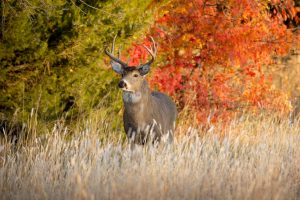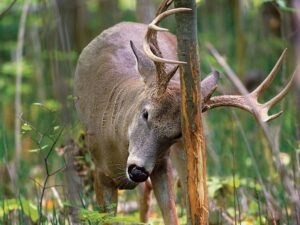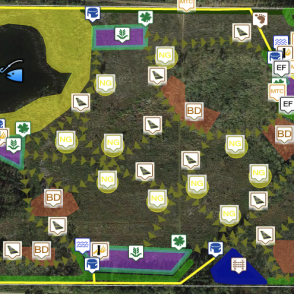Deer Habitat Managers
Deer habitat managers
1- Deer property design/layout/management is fundamentally different than traditional deer hunting. Hunting deer entails scouting for fresh sign and setting up over that sign. Managing the property is manipulating the landscape to dictate deer movement, so you have the advantage, not the deer. If you build a bed to feed pattern around bulletproof access, and include water and social components, the deer will follow the script.
Deer habitat managers is key
2- Accessing stands-
The property should be laid out with access the #1 consideration. You can build a whitetail Utopia, but if you cannot get in and out without the deer knowing, you plan is a failure. Use the major existing roads. Create access roads and trails on property borders. Never drive or walk through food plots when deer are using them. Let the deer know walk the property lines and drive wheelers there. Let them hear you, and smell you. Only be a sneak when its time to hunt. Keep the element of surprise for the days you hunt.
Deer habitat managers


3- Year round food
Food is the biggest need in some areas. Plant as much as you can, but only in the proper spots. Try to fill as many months of the year as you can with food. If you keep the table full year round, your doe herd is safe and sound on your land. In the Midwest, Spring is cereal rye and perennials (clover), summer is perennials and soybeans, early fall is clover, then come the cereal rye, brassica, soybeans and corn during late fall and winter. Clear the table and they will leave, and be killed by the neighbors. Bear in mind you can only hold as many doe groups as you have separate feeding areas. They will fight.
Deer habitat managers
4 – Bedding
Deer in our area often bed on the swamp edges. Does will bed in the first safe available cover adjacent to the food. Make these spots attractive. Bucks will pass by these first choices and seek out solitude. Hinge cut or clear-cut your doe areas close to the food with access to killer stands so you can hunt them. A proper hinge cut offers immediate horizontal cover. A clear-cut will be attractive years 2 through 15 for bedding, so make sure it is in the right spot, or it will cripple your hunting for years. Build some smaller buck thickets the next layer or 2 out so they have a place to stay on your property. It is important to try and create everything the deer need on you parcel. If they leave, they may get shot, or they feel the pressure of sloppy hunting by the neighbors. When they sense this pressure they go nocturnal. You can only control what happens on your parcel, so keep them on your piece and don’t let them know they are being hunted.
5 – Dividing your parcel
You can only effectively hunt a limited part of your parcel. If you are bumping deer going to or from your stand, rethink what you are doing. If you want to enjoy multiple sits on a 100 acre piece, you need to be no impact. The deer cannot know you are hunting them. If you cant hunt it without bumping them, find a new approach, or give up that piece of your land to the deer. Let the deer know what is yours, what is theirs, and hunt them in spots where those worlds grey and offer you an undetectable opportunity. Dive into those deep spots twice a year when everything is perfect (daylight pictures, and a late October early November cold front are a good start) if you must, but no more.

Keep in mind you may wish to leave several areas of your land as deer dead spots. Areas of mature timber the deer will not bed or feed in. These can be you spots for access. Improve the whole piece and deer movement becomes unpredictable.
6 – Tidying up
While we are creating access, bedding and food, keep your eyes open for opportunities to make the good plan great. Examples include:
Plot screens. Tall annual grasses work great to hide you from the deer when entering and exiting stands, or traveling to and fro. They can also shield deer from the neighbor’s eyes.
wandering bucks
Funnels – turn 3 trails into one by knocking some trees over. Make a 100-yard wide spot hunt like a 25-yard wide spot.

Debris from new plots – some like the clean look of new plot in the woods. Some prefer to strategically pile the trees and root balls to give the deer limited access to the food. It’s ugly, but much more hunt able.
5 year plan.
This is a 5 year plan for a couple reasons. The first is your bedding areas take a couple years to become prime. Once those does move in, your doe herd can start to grow and multiply. Give them a pass for a couple of years so you have something to watch, and a lure for the bucks. In a couple years you can start thinning doe numbers if need be. Remember those does are in your control. Give them what they need and only you can kill them.
The second factor is that you need to raise the bucks you shoot to the age and size you desire. Most of the year, those older bucks are only on their feet for the first and last 20 minutes of legal light. If they live on the neighbors, you only get them at night. You may get a crack at a roaming buck, but the more time he spends on your chunk, the better the odds he lives past 1.5, and the better the odds are that you get to kill him. Until they have a secluded spot to call home and live on your farm, your odds of success are very low.

